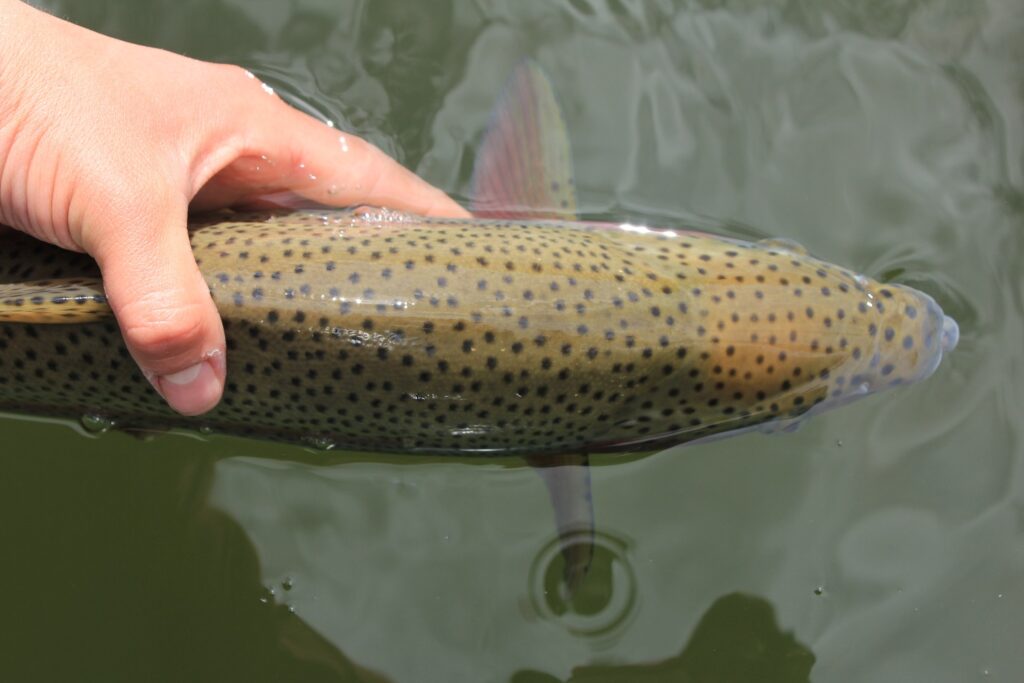In 1969, while in my early teens, my family moved to Kamloops. I quickly took advantage of the outdoors – especially the seemingly endless opportunities to fish. Over the past 50 years, the transportation corridors, vehicles, boats, fishing equipment, and even the way we communicate have all changed. In this time, there has also been a significant shift in peoples’ attitudes toward harvesting trout.
In my youth, virtually all anglers retained most of their catch. The quality of the trout was exceptional, as remains true today. The limit back then was six trout per day, and it was the norm that most anglers would aim to reach this. When the fishing was hot, you caught your limit early in the day, stopped fishing, and headed for home. There was little thought given to releasing fish.
Today, many stillwater anglers subscribe to a different model of fishing: catching and releasing as many fish as possible. And for some of these anglers, it is frowned upon to kill even one of these beautiful trout.
With such diverse attitudes to trout fishing, one must ask, from an ecological and fisheries management standpoint, which is better – should you keep your catch or release it? In my opinion, perhaps the best answer lies somewhere in the middle.
Typically, the highest quality angling lakes we have in B.C. are small ones that are annually stocked by the Freshwater Fisheries Society of BC. A significant amount of scientific research goes into determining the appropriate stocking densities that will yield the best results. Since most of these lakes are relatively productive, trout grow quickly, and can be caught at an age of two years. During hatches of various insects, the fish are particularly susceptible to fly fishers. And because the lakes are stocked, there is no conservation concern for anglers who want to keep their catch.
The practice of catch and release may be important for maintaining opportunities to fish for some wild fish stocks, while still ensuring their long-term survival. However, this is rarely a concern with British Columbia’s productive rainbow trout lake fisheries. If the regulations allow for harvest, then anglers who wish to keep their catch can be confident that harvesting has been determined sustainable by the regional fishery manager.

As long as your harvest is within the bag limit, recreational fishing can be a great way to provide you and your family with some of the freshest, best-tasting, and healthiest foods available. If you like eating the fish you catch, by all means do so.
It is very important to understand when and where to harvest or not harvest your trout. As a general rule, the colder the water, the better the quality and taste of a fish’s flesh. Here are some guidelines to follow for fish retention:
1. Almost all lakes produce quality eating trout in the cool water temperatures of early spring, late fall, and winter. When the shallow, productive lakes in the Interior of B.C. warm up, algal blooms begin, and fish feeding in the algae-rich water acquire the “muddy” flavour of these aquatic plants. If it’s getting into mid-June or later and you can see algae, you will likely be unimpressed by the flavour of the fish, and you may want to consider releasing your catch.

2. If the trout you catch is dark and/or skinny, it may be either a pre- or post-spawned fish. Since such trout have dedicated much of their body fat and nutrients to their gonads, these fish will not be good eating, and it would be best to release them.
3. If you are looking for fish to retain during the summer, try to fish larger, deeper, or higher-elevation lakes. These lakes remain cooler throughout the summer, and fish won’t become muddy-flavoured. Even better, look for kokanee which reside in deep lakes and provide excellent table fare year ’round.
4. If a trout is bleeding or hooked deeply in the throat or gills, it is unlikely to survive, and it’s best to harvest it.
5. Trout flesh is very delicate, and easily damaged by improper handling from the time you land your catch until when you prepare it for a meal. Fish to be eaten should be killed immediately after landing. Since the flesh will become mushy if allowed to overheat, store your fish in a cool area (preferably on ice).

6. Digestive enzymes in a fish’s intestinal tract can also spoil the flesh. It is best to gut and clean your fish as soon as possible.
7. If you choose to freeze your trout, remove as much air as possible from the container it will be stored in to prevent freezer burn. Commercially available units to vacuum-package fish in plastic bags, or placing your trout in small cartons of salted water, work well to protect the frozen flesh. No matter how you store your catch, frozen fish should be eaten within six months of harvest.
Author: Steve Maricle
Images: Steve Maricle
Steve Maricle retired from a 30-year career as a provincial fisheries biologist, and now operates a guiding company. Follow Steve on Instagram or visit his website.
